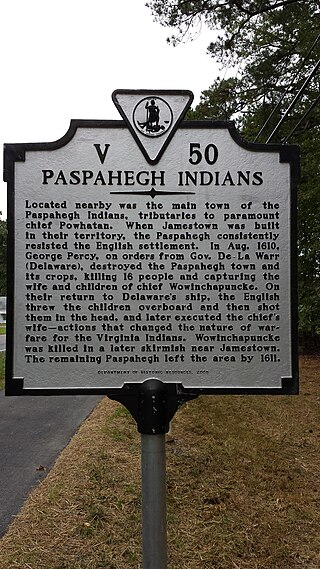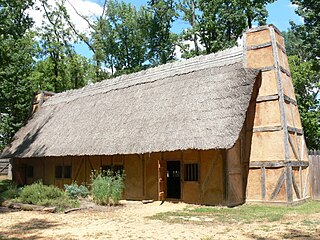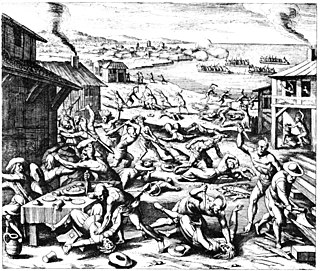Related Research Articles

The Jamestown settlement in the Colony of Virginia was the first permanent English settlement in the Americas. It was located on the northeast bank of the James River, about 2.5 mi (4 km) southwest of the center of modern Williamsburg. It was established by the Virginia Company of London as "James Fort" on May 4, 1607 O.S., and was considered permanent after a brief abandonment in 1610. It followed several failed attempts, including the Lost Colony of Roanoke, established in 1585 on Roanoke Island, later part of North Carolina. Jamestown served as the colonial capital from 1616 until 1699. Despite the dispatch of more settlers and supplies, including the 1608 arrival of eight Polish and German colonists and the first two European women, more than 80 percent of the colonists died in 1609–10, mostly from starvation and disease. In mid-1610, the survivors abandoned Jamestown, though they returned after meeting a resupply convoy in the James River.

The Colony of Virginia, chartered in 1606 and settled in 1607, was the first enduring English colony in North America, following failed attempts at settlement on Newfoundland by Sir Humphrey Gilbert in 1583 and the Roanoke Colony by Sir Walter Raleigh in the late 1580s.

The London Company, officially known as the Virginia Company of London, was a division of the Virginia Company with responsibility for colonizing the east coast of North America between latitudes 34° and 41° N.

John Rolfe was one of the early English settlers of North America. He is credited with the first successful cultivation of tobacco as an export crop in the Colony of Virginia in 1611.

The Powhatan people may refer to any of the indigenous Algonquian people that are traditionally from eastern Virginia. All of the Powhatan groups descend from the Powhatan Confederacy. In some instances, The Powhatan may refer to one of the leaders of the people. This is most commonly the case in historical records from English colonial accounts. The Powhatans have also been known as Virginia Algonquians, as the Powhatan language is an eastern-Algonquian language, also known as Virginia Algonquian. It is estimated that there were about 14,000–21,000 Powhatan people in eastern Virginia, when English colonists established Jamestown in 1607.

Opechancanough was paramount chief of the Powhatan Confederacy in present-day Virginia from 1618 until his death. He had been a leader in the confederacy formed by his older brother Powhatan, from whom he inherited the paramountcy.
Sir Samuel Argall was an English adventurer and naval officer.

Powhatan, whose proper name was Wahunsenacawh, was the leader of the Powhatan, an alliance of Algonquian-speaking Native Americans living in Tsenacommacah, in the Tidewater region of Virginia at the time when English settlers landed at Jamestown in 1607.

The Paspahegh tribe was a Native American tributary to the Powhatan paramount chiefdom, incorporated into the chiefdom around 1596 or 1597. The Paspahegh Indian tribe lived in present-day Charles City and James City counties, Virginia. The Powhatan Confederacy included Indigenous peoples of the Northeastern Woodlands who spoke a related Eastern Algonquian languages.

The "Citie of Henricus"—also known as Henricopolis, Henrico Town or Henrico—was a settlement in Virginia founded by Sir Thomas Dale in 1611 as an alternative to the swampy and dangerous area around the original English settlement at Jamestown, Virginia. It was named for Henry, Prince of Wales (1594–1612), the eldest son of King James I.

Sir Thomas Gates (fl.?–1622), was the governor of Jamestown, in the English colony of Virginia. His predecessor, George Percy, through inept leadership, was responsible for the lives lost during the period called the Starving Time. The English-born Gates arrived to find a few surviving starving colonists commanded by Percy, and assumed command. Gates ruled with deputy governor Sir Thomas Dale. Their controlled, strict methods helped the early colonies survive. Sir Thomas was knighted in 1596 by Robert Devereux, 2nd Earl of Essex for gallantry at the Capture of Cadiz. His knighthood was later royally confirmed by Queen Elizabeth I.

The Indian massacre of 1622, popularly known as the Jamestown massacre, took place in the English Colony of Virginia, in what is now the United States, on 22 March 1622. John Smith, though he had not been in Virginia since 1609 and was not an eyewitness, related in his History of Virginia that warriors of the Powhatan "came unarmed into our houses with deer, turkeys, fish, fruits, and other provisions to sell us". The Powhatan then grabbed any tools or weapons available and killed all the English settlers they found, including men, women, children of all ages. Chief Opechancanough led the Powhatan Confederacy in a coordinated series of surprise attacks, and they killed a total of 347 people, a quarter of the population of the Virginia colony.

The Pamunkey Indian Tribe is one of 11 Virginia Indian tribal governments recognized by the Commonwealth of Virginia, and the state's first federally recognized tribe, receiving its status in January 2016. Six other Virginia tribal governments, the Chickahominy, the Eastern Chickahominy, the Upper Mattaponi, the Rappahannock, the Monacan, and the Nansemond, were similarly recognized through the passage of the Thomasina E. Jordan Indian Tribes of Virginia Federal Recognition Act of 2017 on January 12, 2018. The historical people were part of the Powhatan paramountcy, made up of Algonquian-speaking nations. The Powhatan paramount chiefdom was made up of over 30 nations, estimated to total about 10,000–15,000 people at the time the English arrived in 1607. The Pamunkey nation made up about one-tenth to one-fifteenth of the total, as they numbered about 1,000 persons in 1607.
Charles City was one of four incorporations established in the Virginia Colony in 1619 by the proprietor, the Virginia Company. In 1634, under Royal authority, a portion became Charles City Shire, later Charles City County.

The Anglo–Powhatan Wars were three wars fought between settlers of the Virginia Colony and Algonquin Indians of the Powhatan Confederacy in the early 17th century. The first war started in 1609 and ended in a peace settlement in 1614. The second war lasted from 1622 to 1632. The third war lasted from 1644 until 1646 and ended when Opechancanough was captured and killed. That war resulted in a defined boundary between the Indians and colonial lands that could only be crossed for official business with a special pass. This situation lasted until 1677 and the Treaty of Middle Plantation which established Indian reservations following Bacon's Rebellion.
The Starving Time at Jamestown in the Colony of Virginia was a period of starvation during the winter of 1609–1610. There were about 500 Jamestown residents at the beginning of the winter; by spring only 61 people remained alive.
Berkeley Hundred was a Virginia Colony, founded in 1619, which comprised about eight thousand acres (32 km²) on the north bank of the James River. It was near Herring Creek in an area which is now known as Charles City County, Virginia. It was the site of an early documented Thanksgiving when the settlers landed in what later was the United States. In 1622, following the Indian Massacre of 1622, the colony was for a time abandoned. In the mid 18th century, it became known as Berkeley Plantation, the traditional home of the Harrison family of Virginia. In 1862, amid fighting in the Civil War, the area was the scene of the creation and first bugle rendition of present-day "Taps".
Henry Spelman (1595–1623) was an English adventurer, soldier, and author, the son of Erasmus Spelman and nephew to Sir Henry Spelman of Congham (1562–1641). The younger Henry Spelman was born in 1595 and left his home in Norfolk, England at age 14 to sail to Virginia Colony aboard the ship Unity, as a part of the Third Supply to the Jamestown Colony in 1609. He is remembered for being an early interpreter for the people of Jamestown as well as writing the Relation of Virginia, documenting the first permanent English colonial settlement in North America at Jamestown, Virginia, and particularly the lifestyles of the Native Americans of the Powhatan Confederacy led by Chief Powhatan.

Jamestown, also Jamestowne, was the first settlement of the Virginia Colony, founded in 1607, and served as the capital of Virginia until 1699, when the seat of government was moved to Williamsburg. This article covers the history of the fort and town at Jamestown proper, as well as colony-wide trends resulting from and affecting the town during the time period in which it was the colonial capital of Virginia.

Opossunoquonuske, was a Weroansqua of an Appomattoc town near the mouth of the Appomattox River. Weroansqua is an Algonquian word meaning leader or commander among the Powhatan confederacy of Virginia coast and Chesapeake Bay region. She was known as the queen of Appamatuck, The community she led was large enough to provide an estimated twenty warriors to the Powhatan Confederacy.
References
- ↑ "How Counties Got Started in Virginia". virginiaplaces.org. Retrieved 9 September 2010.
- 1 2 3 Macpherson, Heidi Slettedahl; Kaufman, Will (October 2005). "The State of (Dis)Union: American Studies in Britain". Prospects. 30: 27–43. doi:10.1017/s0361233300001964. ISSN 0361-2333.
- 1 2 Donnelly, Ralph W. (1959). "The Confederate Lead Mines of Wythe County, Va". Civil War History. 5 (4): 402–414. doi:10.1353/cwh.1959.0019. ISSN 1533-6271.
- ↑ "Starving", How Food Made History, John Wiley & Sons, Ltd, pp. 215–236, 2011-10-05, doi:10.1002/9781444344677.ch10, ISBN 9781444344677
- ↑ Deal, D. (2006-09-01). "A Land as God Made It: Jamestown and the Birth of America". Journal of American History. 93 (2): 493–494. doi:10.2307/4486246. ISSN 0021-8723. JSTOR 4486246.
- ↑ The Facts on File encyclopedia of word and phrase origins. 2004-09-01.
- ↑ Mancall, Peter C. (December 2007). "Savagery in Jamestown:"George Percy's 'Trewe Relacyon'": A Primary Source for the Jamestown Settlement";A New World: England's First View of America;Writings, with Other Narratives of Roanoke, Jamestown, and the First English Settlement of America;The Journals of Captain John Smith: A Jamestown Biography". Huntington Library Quarterly. 70 (4): 661–670. doi:10.1525/hlq.2007.70.4.661. ISSN 0018-7895.
- ↑ Cotter, John L. (March 1957). "Excavations at Jamestown, Virginia. Site of the First Permanent English Settlement in America". Antiquity. 31 (121): 19–24. doi:10.1017/s0003598x00027022. ISSN 0003-598X. S2CID 164132527.